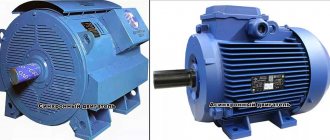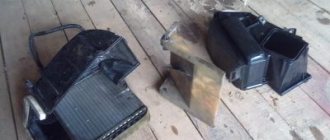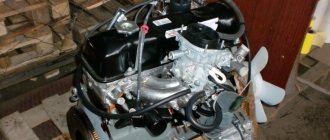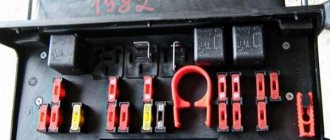We distinguish VAZ 2105 from VAZ 2107: what is the difference between the models?
The models differ significantly from each other
“Five” and “Seven”: what distinctive features do these two models of domestic cars have? Why do experienced car enthusiasts today increasingly prefer products from the domestic automotive industry? What should you know when choosing between VAZ 2105 and VAZ 2107? Let's try to figure it out.
The good old Zhiguli has established itself as a good and reliable brand, the price/quality ratio of which forces the buyer to choose this particular domestic car. And yet, what is the difference between the VAZ 2105 and the VAZ 2107, if the new “seven” exceeds the “five” in price? Which model to choose: 2105 or VAZ 2107?
At the peak of their popularity, these two models had significant differences. Until 1988, the VAZ 2107 was equipped with such devices.
- Brake pad wear sensors.
- Crankshaft position sensor.
- Headlight washer.
- Relay-breaker for the parking (hand) brake warning lamp.
- Generator G-222.
- Contactless transistor ignition system.
- Oil pressure sensor.
- General technical diagnostic block.
In the 90s, manufacturers replaced or removed all these components, thereby reducing the cost of the VAZ 2107. But “fives” and “sevens” are still produced today, having great popularity in the domestic market, and they differ only slightly. Which is better: “five” or “seven”? There is no clear answer. It is generally accepted that the VAZ 2107 is an improved model of the “five”, but is this really so?
External differences between models
- The “Seven” has a chrome radiator grille, while in the VAZ 2105 it is made of black plastic. For practical drivers, the second option will seem the best, since if you frequently use the services of a car wash, the grille of the “Seven” will very quickly take on a not the most presentable appearance, since it is susceptible to corrosion and delamination of the chrome coating.
- The “Seven” has a wider “range” of instruments: a tachometer, an econometer, a center console with an output for a radio and a clock. The “Five” can only boast a socket for the radio, which is located under the front panel, and access to it is a little difficult.
- The trunk lid of the “five” has indentations, while on the “seven” it is absolutely straight and smooth.
- The structure of the taillights is different.
- The front seats are equipped with comfortable headrests, which is typical for the “Seven”.
Technical characteristics of the “five” and “seven”
- The VAZ 2107 has a slightly different ventilation system (cold air deflector): air is taken in directly, not through the heater radiator. In the VAZ 2105, ventilation is carried out through the “stove” radiator.
- Some models of “fives” and “sevens” of different years of production have differences in engine power: 77 horsepower for the 2107 and 69 “horses” for the “five”.
- The piston stroke and cylinder size are also different: 66x79 in the “five” and 80x76 in the “seven”.
- Acceleration time to 100 km/h.
The VAZ 2107 accelerates from a standstill in 15 seconds, and the 2105 in 18 seconds.
This is probably where the differences end; then we can only talk about the similarities:
- both models have rear-wheel drive;
- body type and number of seats, permissible additional trailer weight and braking distance, gearbox and steering mechanism, fuel tank and suspension, battery, generator and starter are absolutely identical for both models.
Appearance of headlights of models
VAZ is somewhat superior to other domestic car brands: their models have always been distinguished by the reliability and wear resistance of components, the relative cheapness of parts, spacious interior, and height (which is especially important for domestic off-road use).
Disadvantages to watch out for
But it was not without its drawbacks either. VAZ 2107 and VAZ 2105 have certain shortcomings that prevent car enthusiasts from making a choice in favor of these particular models.
Tuning of domestic cars
- Due to poor design, the wipers clear a very small area of the windshield, making visibility difficult in adverse weather conditions.
- The steering wheel is too large in diameter, which can be a real problem for a “large-sized” driver. But on the “seven” the steering wheel is more comfortable due to its matte structure. It does not slip in your hands, which cannot be said about the steering wheel of the “five”, so it is better to immediately purchase a steering wheel cover if you buy a 2105.
- The side mirrors are too small, making visibility difficult. The problem can be solved at the nearest service station, but requires additional investment.
- The steering wheel is tight and the braking distance is long. The driver needs to get used to it in order to drive the car carefully and safely. The lack of amplifiers on the steering system is a significant drawback.
- The “internal filling” of models of recent years of production tends to creak when driving over uneven surfaces. This is explained by the poor quality of the plastic from which the internal front panel and instruments are made.
- The location of the pedals will not be convenient for everyone: you will have to master the “wide seat” in order to maneuver skillfully. The pedals are placed high and too far apart from each other, but for drivers who have been driving the “classic” for many years, this feature is completely invisible. Only beginners who have learned to drive foreign cars will see it.
- Models are too noisy. They cause real migraine attacks in some drivers and force them to contact car services for soundproofing work. The “symphony” of aerodynamics and transmission, the “melody” of seals and the “bass” of the engine can become a real problem for a car enthusiast.
And what is better: to buy a VAZ 2105 or a VAZ 2107? Each driver must give the answer to himself. The higher price of the 2107 is compensated by additional devices and a rather presentable front bumper. In all other respects, these are almost identical models.
Source: https://expertvaz.ru/2107/kak-otlichit-2105.html
Engine
This is an important part of any car. But due to the peculiarities of AvtoVAZ’s production policy, this is not a detail by which one can understand how the VAZ-2105 differs from the VAZ-2107.
On the VAZ-2105, in addition to engines 2101 and 2103, a model with the index 2105 was installed. It was created by making several changes to the design of 21011:
- Timing belt drive instead of chain drive.
- Cast aluminum cylinder head cover.
- Recesses for valves to prevent damage if the belt breaks.
These measures have led to a significant reduction in noise from engine operation and an increase in service life.
The VAZ-2107 was equipped with the following engines: 2103, 2105 and 2106 with a volume of 1500, 1300 and 1600 cm 3, respectively. There were also modifications for the needs of the traffic police, the Ministry of Internal Affairs and the KGB. They used a VAZ-4132 rotary piston engine with a volume of 1.6 liters and a power of 140 hp. With.
What is the difference between a five and a seven car?
These products of our automotive industry are still quite popular among many people. Cars of the declared brands are distinguished by their affordable price, simplicity and ease of maintenance, and low fuel consumption, compared to cars with more than 100 horsepower. The question often arises: what is the difference between the VAZ 2107 and 2105. You can try to figure it out.
Appearance
The exterior of the cars is practically the same, only a closer look reveals some differences. The 2107 radiator grille is made of plastic with a special chrome-plating coating; the 2107 has a nondescript version made of non-shiny black plastic. From a practical point of view, a “chrome” grille will be more susceptible to wear and corrosion, and with each washing process the coating will oxidize and then fall out.
The trunk lid of the 2107 looks more solid, thanks to the stamped relief, while the 2105 has a completely flat shape. The hood of the car also has minor differences in external similarity; in 2107 it has several additional bulges.
The head optics of the 7th model Zhiguli are equipped with a reflective element, which has both a visual difference from the 5th model and a brighter and more directional luminous flux. The 2107's taillights have a square rear light zone, while the 2105's are rectangular. The bumpers of the seventh model are made of carbon steel, while those of the five are aluminum.
The hood and trunk lids of VAZ models differ in the form of stamping. In the “seventh” model of the Lada, the hood lid has a higher relief than the hood of the VAZ 2105. And the trunk lid, on the contrary, in the seventh model has a flat surface, and on the “five” the lid is a stamped part with recesses.
Lada bumpers are made of different alloys. The “five” has both bumpers made of aluminum, while the VAZ 2107 has two bumpers made of carbon steel.
Interior
The interior of the VAZ seventh model is distinguished by the presence of additional functional options:
- The seats for the driver and passengers of the VAZ 2107 are equipped with headrests, which the Lada “fifth” model cannot boast of.
- In the 7's interior heating system, air is taken in through a central air duct in the engine compartment. For the “five” heating system, the air passes through the radiator.
- The dashboard of the Lada “seventh” model has a tachometer and a fuel economy sensor.
- On the very first VAZ 2107 cars, produced in the 80s, brake pad wear and engine oil pressure sensors were installed.
- The VAZ 2107 car had speedometers with a marked scale up to 180 km/h. On the “fives” the speedometers are marked up to 160 km/h.
- The VAZ 2107 interior is equipped with cold air flow deflectors responsible for ventilation.
- On more modern versions of the VAZ 2107, the visual appearance of the door trim, headliner, and plastic trim on the rear pillars has changed.
- Initially, the “seven” was distinguished by a new radio panel, the shape of the steering wheel, and the appearance of the gear shift lever. Subsequently, these innovations also affected the interior of the Lada “fifth” model.
- On the central console of the VAZ 2107 there is a clock and there are connections for the car radio. The “five” only has an inconveniently located hole for installing a radio.
In the fifth version, these options are missing, there is only an inconvenient cutout for the car radio. The interior heating system in the VAZ 2105 model takes air directly from the heater radiator; in the 2107, the air enters directly through the central air duct, through an opening in the engine compartment.
Engine
The Lada seventh model is equipped with both carburetor and injection engine modifications. In the carburetor version, the VAZ 2107 has an advantage in power by 8 horsepower, its power unit produces 77 horses, and the 2105 engine produces 69. In addition, the seven has an increased piston stroke and cylinder diameter, in the proportion: 67x69 to 80x76, respectively. The displacement of VAZ carburetor engines of the seventh model can be from 1.3 to 1.7 liters, depending on the modification, the five also have several modifications from 1.2 liters to 1.6, there are 2105 with an engine capacity of 1.45 liters , but this is a rare option.
Differences in appearance
The most important difference that catches your eye is the radiator grille. On the VAZ-2107 it is larger, its upper edge is equal to the hood. Moreover, the grille is chrome plated, which gives the car an attractive look. The front of the car looks somewhat more aggressive than that of the 5, which has a black plastic grille and a much smaller size.
The seven's bumper is made of durable plastic, just like the five's. But the latter has two metal chrome trims located on the top and bottom of the bumper. But the seven has only one such overlay, it is located on the upper part. But the bumper of the VAZ-2107 still looks a little more impressive; outwardly it seems larger than that of the VAZ-2105.
In addition, the taillights of cars are designed differently. The seven, for example, has a large reversing light, occupying half the entire length of the optics. And for the five it is two times less. And the chemical composition of the plastic from which the flashlights are made is much better in the seven, therefore, the product is more durable.











